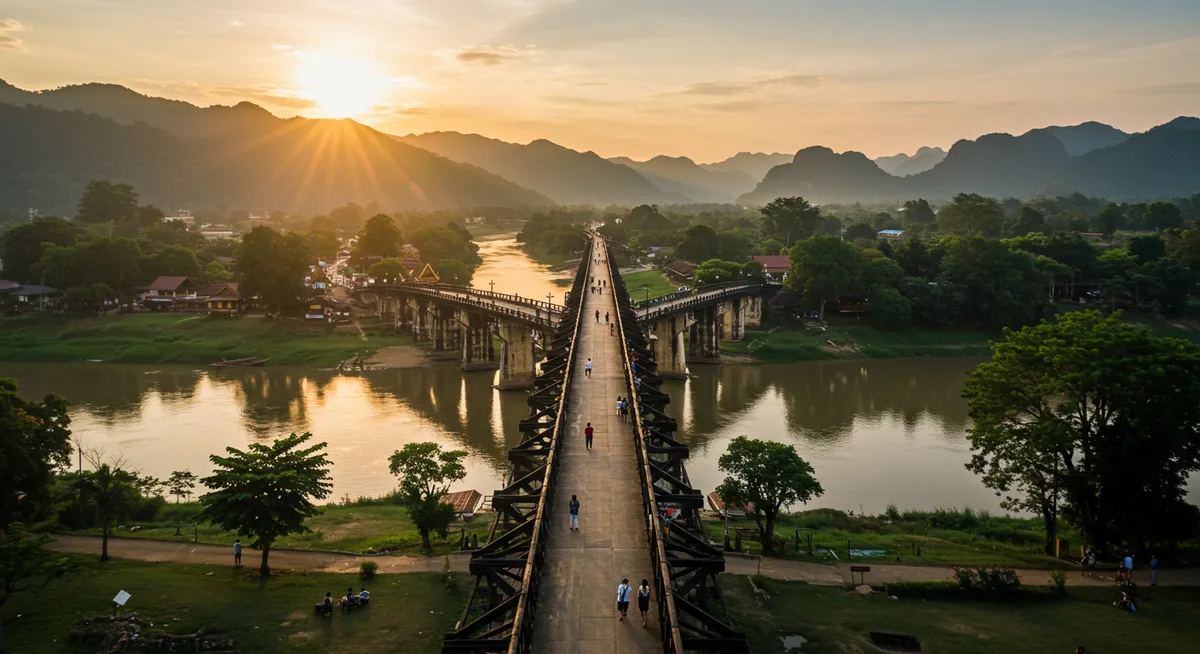
Kanchanaburi War History Sites: A Somber Journey
Table of Contents
Want to find the best travel deals for this destination? Chat with our travel hacking specialist!
Get Travel HacksCategory: kanchanaburi-war-history-sites
Exploring Kanchanaburi's World War II Legacy
Having personally traversed the historic landscapes of Kanchanaburi, I can attest to the profound impact of its wartime heritage. This Thai province, nestled by the River Kwai, holds a poignant chapter of World War II history, primarily linked to the construction of the Burma Railway. Visiting the various Kanchanaburi war history sites offers a vital opportunity to reflect on the immense human cost of conflict and honor those who suffered. It's a journey into remembrance, inviting visitors to pay respects and understand the sacrifices made during a dark period of global history. For a broader overview of the region, consider consulting our comprehensive Kanchanaburi Travel Guide.
The Iconic Bridge on the River Kwai
The Bridge on the River Kwai stands as the most recognized of all Kanchanaburi war history sites, symbolizing both the horrors and resilience of wartime. This steel viaduct, originally part of the Thailand-Burma Railway, was built by Allied prisoners of war (POWs) and Asian laborers under brutal conditions. Visitors can walk across sections of the bridge, still used by local trains, and imagine the arduous circumstances of its creation. A practical tip: arriving early helps you beat the crowds and experience a more reflective atmosphere. Near the bridge, you'll find various memorials and small markets, adding layers to this significant historical landmark.
JEATH War Museum: Personal Accounts of Suffering
For an intimate look into the lives of POWs, the JEATH War Museum provides a stark, educational experience. JEATH stands for Japanese, English, Australian, Thai, and Holland, representing the nationalities involved. This museum, recreated as bamboo huts similar to those used by the POWs, showcases artifacts, photographs, and personal drawings. It offers harrowing insights into the daily struggles and deprivation endured during the railway's construction. Visiting the museum truly helps one grasp the human scale of the tragedy embedded in these Kanchanaburi war history sites. I found the personal testimonials particularly moving, offering a direct connection to those who suffered.
Don Rak War Cemetery: A Place of Serene Reflection
The Kanchanaburi War Cemetery, also known as Don Rak, is a beautifully maintained and deeply moving memorial. It is the final resting place for nearly 7,000 Allied POWs who perished during the construction of the Death Railway. Rows of impeccably kept gravestones, each bearing a name and a poignant inscription, stretch across the manicured lawns. This serene environment invites quiet contemplation and respectful remembrance. It’s a vital component of the Kanchanaburi war history sites, offering a powerful visual testament to the ultimate sacrifice made. Planning a visit here is essential for anyone seeking to honor the memory of those lost.
Hellfire Pass Interpretive Centre and Memorial
Further afield, the Hellfire Pass Interpretive Centre and Memorial commemorates one of the most brutal sections of the Death Railway, where POWs were forced to carve through rock with minimal tools. The sheer scale of the cutting, performed under harsh conditions often at night by lamplight, gave it its ominous name. The memorial walk along the original railway cutting is incredibly poignant, amplified by audio guides providing survivor testimonies. It offers a profound sense of the immense physical and emotional toll. This remote yet critical site enhances our understanding of the broader context of Kanchanaburi war history sites. To integrate this into a longer trip, consider our Kanchanaburi Itinerary for 3 Days.
Frequently Asked Questions
What is the significance of the Bridge on the River Kwai?
Are the Kanchanaburi war history sites suitable for children?
How can I visit multiple war history sites in Kanchanaburi?
The Kanchanaburi war history sites offer more than just historical facts; they provide a deeply moving journey into a difficult, yet crucial, chapter of human history. From the engineering marvel and human cost of the Bridge on the River Kwai to the solemn serenity of the war cemeteries and the raw testimonials at the museums, each location profoundly impacts visitors. It's a testament to resilience, a call for remembrance, and a stark reminder of peace's value. We encourage every traveler to immerse themselves in this unique part of Thailand's past, fostering a deeper appreciation for the lessons history offers. Start planning your respectful visit to Kanchanaburi today and carry these powerful stories forward.